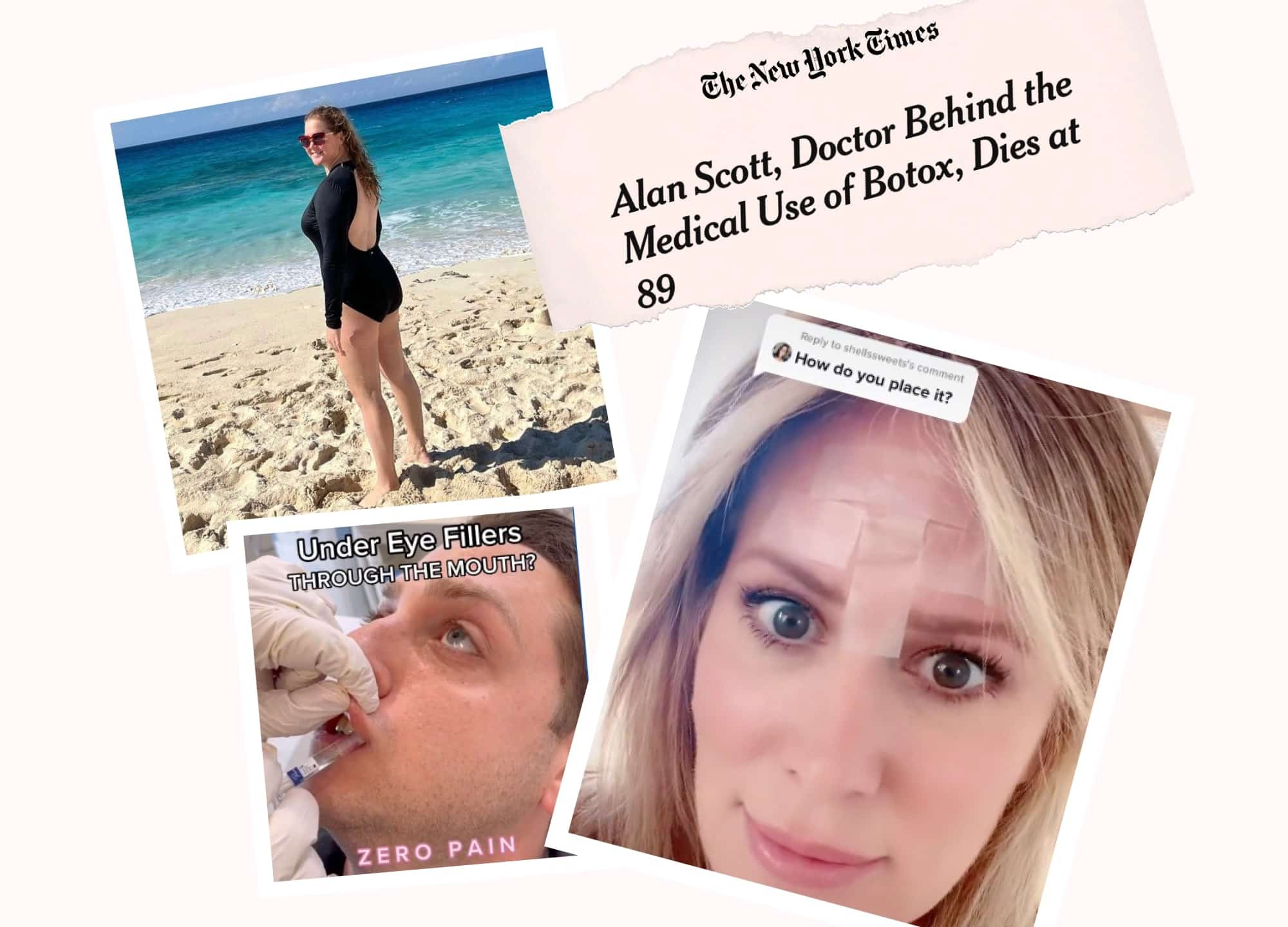Every month, we strive to bring you a balanced mix of breaking news (stars getting procedures, for instance, or coming-soon treatments) and advice you can always use, like what to expect after a tummy tuck or how to determine if masseter Botox is right for you. Invariably though, there’s an intriguing headline or viral post that doesn’t make its own stand-alone story yet is still worthy of a share.
Which brings us here, to the first installment of This Month in Aesthetics, an ICYMI recap of industry-molding moments that we’d be remiss not to acknowledge—from one celeb’s IG liposuction confession to the device announcement that left doctors digging for more details.
Amy Schumer opens up about endometriosis surgery and lipo
“I feel good. Finally,” begins the caption of Amy Schumer’s wave-making beach pic posted to Instagram earlier this month. The comedian and actor goes on to thank the surgeons who helped to restore her body and confidence. Schumer has spoken candidly before about her difficult pregnancy and the complicated C-section birth of her now 2-year-old son, Gene, as well as her lifelong struggles with endometriosis and chronic pain. Last fall, she underwent surgery to remove her uterus, appendix, and other tissues ravaged by the condition. As revealed in her most recent Instagram post, she subsequently had liposuction with board-certified New York City plastic surgeon Dr. Jordan S. Terner.
Alluding to plastic surgery, Schumer writes, “Never thought I would do anything, but talk to me after your uterus doesn’t contract for 2.5 years and you turn 40.” Famous for her transparency, the star has previously copped to getting cheek filler and CoolSculpting CoolMini.
According to Dr. Terner, Schumer “wasn’t feeling so confident about the way she was looking.” Chronic-pain conditions, like endometriosis, can render patients sedentary, causing them to gain weight. “Amy hadn’t been able to work out, she was in pain, she was feeling bloated—and she wanted a kickstart to get back in shape,” Dr. Terner tells us. While lipo is not a weight-loss method, “it can really shape you by targeting certain trouble spots,” he adds. “It’s not about being the skinniest—it’s just about having a nice shape and feeling good about yourself.”
Patients like Schumer, who are rebounding from pregnancy and abdominal surgery, can often benefit from “some reconstructive or aesthetic addressing of their abdomen and flanks,” Dr. Terner says, be it via tummy tuck surgery and/or liposuction. “Everyone’s anatomy and needs are different,” he explains. “In Amy’s case, she did really well with lipo alone. She’s comfortable in her own skin, and she likes who she is—she just wants to be the best she can be.”
Botox reduces anxiety, according to a new study
A new study from the Skaggs School of Pharmacy and Pharmaceutical Sciences at University of California San Diego finds that people who received Botox injections for certain cosmetic and medical reasons reported an overall 22%–72% decrease in levels of anxiety.
While researchers are still working to understand precisely how the neuromodulator exerts its anti-anxiety effect, they note that the drug’s pacifying influence was “observed not only for cosmetic use in facial muscles but also for other indications and injection sites,” including the treatment of migraines, upper- and lower-limb spasms, and torticollis and neck pain.
Scientists have been investigating the mental health benefits of Botox for more than a decade, and the drug is currently in clinical trials for the treatment of depression.
Injectors buzzing over controversial under-eye filler technique
In early January, Dr. Ramtin Kassir, a board-certified New York City facial plastic surgeon, posted this video of himself injecting a patient’s tear troughs with filler—from inside their mouth. In his post, Dr. Kassir claims that the unorthodox technique “helps minimize and eliminate the chance of bruising” while creating “zero pain”—a point that the patient in the video confirms, saying he felt “nothing” while having his under-eye hollows injected.
Injectors flooded the comments with a mix of curiosity and concern over sanitation and potential for infection when going through the mouth. Several providers reposted the video, cautioning against the technique and debunking its supposed benefits.
“This is not my idea of sterile technique, because the mouth has a very dirty environment,” says Dr. Flora Levin, a board-certified oculoplastic surgeon in Westport, Connecticut, in her reaction post. She notes that pain is a nonissue with traditional under-eye injection technique using a needle or blunt-tipped cannula—“with needles, there’s almost no pain,” she says—and adds that the chance of bruising is minimal when filling the under eyes with a cannula.
In a comment on Dr. Levin’s post, board-certified Nanuet, New York, dermatologist Dr. Heidi Waldorf agrees with her assessment and points out that intraoral injection of the tear troughs is not new: “That was a thing people suggested >15 years ago, and it died out for exactly [the] reason you state—introducing bacteria! [I] can’t believe it’s being touted again 🤦♀️”
Dr. Kay Durairaj, a board-certified facial plastic surgeon in Pasadena, California, offered a more balanced take in her regram, defending—but not exactly condoning—Dr. Kassir’s approach. Her caption reads: “This is a legitimate approach for under-eye fillers and can be done, with good technique and anatomical knowledge. Facial plastic surgeons go through extensive surgery training in this area and have exceptional knowledge of the facial arteries and veins. Is there bacterial and fungal yeast in the mouth? Yes! The mouth is not sterile. Skin can be sterilized, and thus transcutaneous is a better approach in my opinion. As a head and neck surgeon, we often operate in the mouth for cancer resection, trauma, reconstructive free flaps and more—the oral bacteria seed the entire field. But in surgery, we give perioperative antibiotics and lots of irrigation and periodic rinses, lots of close observation in the hospital. The circulation and blood flow to the face make infection rare for our head & neck patients. YES, this is safe! Many injectors try trendy techniques without the appropriate training required. This can be unsafe for new injectors because of possible bacterial infections and filler infections! With a sterile route available, that’s my preference for aesthetic procedures!”
TL; DR: Addressing dark circles through the mouth is not standard procedure, and while certain surgeons may have the training to do so safely, injecting through disinfected skin is certainly a less risky approach to under-eye filler.
Emsculpt manufacturer to launch new facial device in 2022
BTL, the manufacturer of muscle-toning machines Emsculpt NEO and Emsella, announced in a press release that it has developed a new face-focused device called EMFACE, which “utilizes a patented technology of muscle contraction and skin tissue heating.” While the company claims that its latest innovation “is the result of combining many years of institutional knowledge of the simultaneous emission of radio frequency [RF] and electromagnetic energies,” it hasn’t yet elaborated on how the trademarked high-intensity focused electromagnetic (HIFEM) tech will translate to the face.
Emsculpt is, of course, known for building the abs, glutes, and muscles of the arms and legs by inducing thousands of muscle contractions within a short timeframe. When tuned to certain settings, the device can also burn fat with RF heat.
RealSelf reached out to the company as well as several providers for additional info on the forthcoming device, but none had details to share at the time of our inquiry. BTL plans to debut EMFACE later this year.
Doctor famous for pioneering the medical use of Botox dies
Ophthalmologist and researcher Dr. Alan Scott, the first to use botulinum toxin for medical purposes, died on December 16, 2021, at the age of 89, according to The New York Times.
In 1978, Dr. Scott injected the toxin, then called Oculinum, into the eye muscles of a patient suffering from double vision. After a successful inaugural treatment, Dr. Scott went on to develop the drug as a nonsurgical fix for other ocular conditions, like blepharospasm (eyelid twitching) and strabismus (crossed eyes).
In the early eighties, ophthalmologist Dr. Jean Carruthers joined Dr. Scott’s practice. While both physicians reportedly noticed the drug’s frown-relaxing side effect when treating blepharospasm patients, it was Dr. Carruthers who crossed over into aesthetics, testing Oculinum on patients with deep frown lines and ultimately pioneering the cosmetic use of botulinum toxin. According to Dr. Carruthers, Dr. Scott wasn’t interested in the drug’s wrinkle-smoothing perks. He was later quoted describing the toxin’s cosmetic uses as “charming” and “slightly frivolous.”
In 1991, Dr. Scott sold Oculinum to Allergan, which changed the drug’s name to Botox the following year.
As a testament to Dr. Scott’s trailblazing work, the current roster of FDA-approved medical uses for Botox now includes not only blepharospasm and strabismus but chronic migraines, overactive bladder, cervical dystonia, spasticity, and excessive sweating.
Former Dr. Brandt employee shares anti-wrinkle face-tape tip
Aesthetician Kat James, founder of Shine Beauty Collective Malibu, took to TikTok to share a wrinkle-busting secret she reportedly picked up while working for legendary dermatologist Dr. Fredric Brandt. (While she recorded the tutorial last fall, it started getting media buzz only this month.) James calls it “tape training” and credits the move with keeping her forehead glassy at almost 50 years old. The simple hack involves placing several two-inch strips of scotch tape vertically between the brows and horizontally across the forehead. When we involuntarily scrunch our foreheads or furrow our brows, the tape crinkles. Over time, we learn to quiet the tape by minimizing those movements—and the wrinkles they inevitably etch into our skin.
The video has garnered more than 124,000 likes—and a fair amount of does-she-or-doesn’t-she speculation regarding James’ own personal Botox use. The goal of the tape, she reiterates in the comments, isn’t to freeze muscles, as neurotoxins do, but to boost our awareness of frowns and furrows so that we can better control them—and hopefully make fewer lines as a result.











